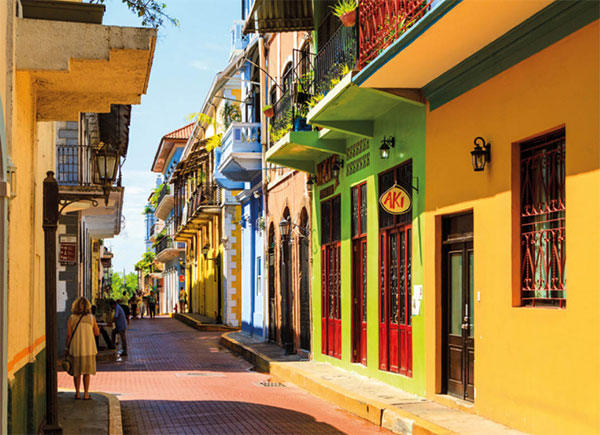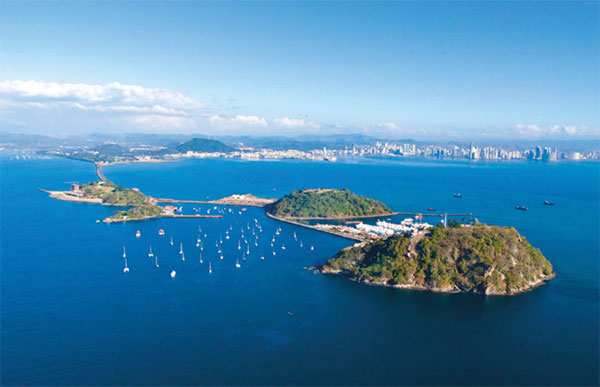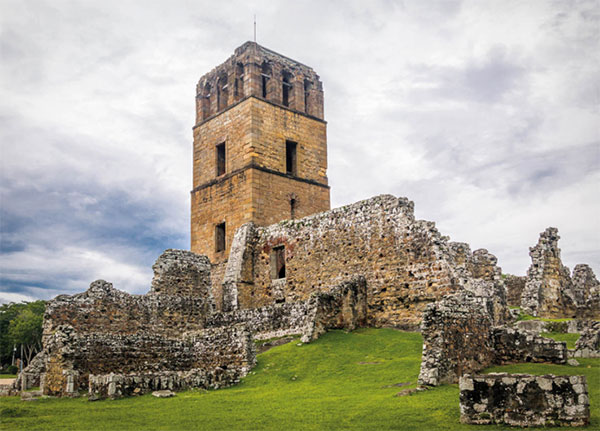Casco Viejo
Bordered by the Pacific Ocean to the southeast and the Panama Canal to the west, Panama City sprawls out in a maze of congested neighborhoods that rarely follow any sort of order. While few parts of the Panamanian capital are walkable, Casco Viejo A [map] , also called Casco Antiguo, is an exception. Declared a World Heritage Site in 1997, Casco is the oldest part of the city and by far the most atmospheric. Over the past two decades, the neighborhood’s stock of centuries-old Spanish, Italian, and French-influenced architecture has been gradually restored, transforming it from a gritty barrio to one of the most gentrified areas of the city. While some parts of Casco still can be quite dangerous, the bulk of the peninsula is home to boutique hotels, rooftop bars, and a wide range of upscale stores and restaurants.

Casco Viejo’s colorful streets.
iStock
Plaza de la Independencia, where Panama declared its independence from Colombia, is flanked by several interesting sights: the neoclassical Catedral Metropolitana (hours vary; free); the Museo del Canal Interoceánico (www.museodelcanal.com; Tue–Sun 9am–5pm), which was built in 1875 and was used as offices for the French and later US canal, and now contains historical documents and artifacts related to the construction of the canal; and the Hotel Central (www.centralhotelpanama.com), once the most luxurious hotel in the region before being neglected for decades and finally restored to its former glory. Down Calle 6a Este is the Presidential Palace, a stunning Spanish mansion with a Moorish interior patio, inaccessible to tourists.
A few blocks to the northeast is Plaza Bolívar, home to the Palacio Bolívar, which contains the Salón Bolívar (Tue–Sat 9am–4pm), a room that hosted the 1826 congress organized by liberator Simón Bolívar to discuss the unification of Colombia, Mexico, and Central America. The building is now the home of the Ministry of Foreign Relations. Next door is one of the oldest buildings in Casco, the Iglesia y Convento de San Francisco de Asís (hours vary; free), although much of it was destroyed in a series of fires in the mid-1700s. At the corner of the plaza is the Teatro Nacional (www.teatronacional.org; hours vary; free), dating to 1908 and designed by Italian architect Genaro Ruggieri, which hosts opera, theater, and other performance art. Inside are frescoes by renowned Panamanian painter Roberto Lewis.

Plaza de Francia, on the southeastern corner of Casco, is sided by Las Bóvedas, a series of jail cells that have been restored and now contain several upscale stores and cafés. Leading from the plaza is the colonial-era stone promenade Paseo Esteban Huertas, where several Kuna women sell handcrafted molas.
Plaza Herrera on the western side of Casco is home to several important hotel projects, including the American Trade Hotel (www.americantradehotel.com) that was created in the 1917 neoclassical headquarters of the American Trade Developing Company.
The Amador Causeway
South of Casco, extending into Panama Bay, is the Amador Causeway B [map] , which connects the four tiny islands of Naos, Culebra, Perico, and Flamenco. These islands, connected with the dirt and rock that was excavated during the Culebra Cut, form a protective harbor for ships waiting to enter the Panama Canal. It was a military zone used by the US until the handover in 1999, when the government opened it to the public. It’s now a popular walking and jogging trail and the home of several major projects.

Aerial view of Amador Causeway.
iStock
First and foremost is the Frank Gehry designed BioMuseo (www.biomuseopanama.org; Tue–Fri 10am–4pm, Sat–Sun 10am–5pm), a $100 million biodiversity museum that took a decade to build. It is notable for its multicolored roof plates and eight different interior galleries, each displaying a different piece of the formation of the Panamanian isthmus. Farther down the causeway, at the Smithsonian’s Tropical Research Institute, is the Punta Culebra Nature Center (www.stri.si.edu/visit/punta-culebra; Tue–Sun 10am–6pm, Mar–Dec Tue–Fri 1–5pm), where visitors can explore the marine and coastal environment on trails through the tropical dry forest and various exhibitions of native flora and fauna.
The Modern City
To the northeast of Casco Viejo, running along the coast, are a string of neighborhoods like Marbella, Bellavista, Punta Paitilla, and Punta Pacífica C [map] that are nearly indistinguishable from each other. They are dominated by a sea of glitzy glass and steel skyscrapers where the city’s wealthiest residents live, and which seems to grow denser every month. Running along the waterfront is the Cinta Costera D [map] , a green space with a cycling and jogging path.
The interior neighborhoods of El Cangrejo, Obarrio, and the Area Bancaria form much of the city’s business and financial district, though residential and hotel projects are also concentrated here. San Francisco to the north is where the city’s best dining can be found, such as at renowned contemporary restaurant Panamanian Maito (www.maitopanama.com). Albrook E [map] , to the south, is home to the domestic airport and bus terminal and more residential, home to wooden houses with wide verandas that were built during the days of US control of the canal.
Cerro Ancón F [map] , a jungle-clad hill close to Casco, has a 360-degree view of the city. Aside from the more residential lower slopes, the reserve is mostly undeveloped and it’s possible to encounter animals like sloths, armadillos, coati, and Geoffrey’s tamarins.
Panama Viejo
The original settlement of Panama City, Panama Viejo G [map] (www.patronatopanamaviejo.org; Tue–Sun 8.30am–5.30pm), founded by the conquistador Pedrarías Dávila in 1519, was burned down after being sacked by Henry Morgan in 1671. At the time, there were as many as 10,000 people living there, though thousands died in the attack. When the settlement was moved a few kilometers west to present day Casco Viejo, which could be better defended, much of the stone went with it.
The ruins today, a Unesco World Heritage Site, are hidden within the encroaching jungle and are largely surrounded by modern suburbs. The restored Plaza Mayor and a bell tower from what was Panama’s original cathedral form most of what remains today, along with a few walls and minor buildings. The visitor center has a model of the city before it was destroyed, as well as a few colonial artifacts.
Isla Tabogo and Las Perlas
Reached by daily ferries from the Amador Causeway, Isla Taboga 2 [map] , known as the ‘island of flowers,’ is the nearest offshore island to Panama City. Just 19km (12 miles) off the coast, it’s an easy day trip with a few good beaches like Playa Restinga and laid back restaurants.
Farther out is the Archipiélago de Las Perlas 3 [map] , 64km (40 miles) from Panama City, reached by ferry or a 20-minute flight. There are more than 200 small islands here, the majority of which are uninhabited. Fine snorkeling, big game fishing, and unspoiled beaches are all found here and while there have been rumblings about development in recent years, it hasn’t happened yet.

Ruins of Panama Viejo.
Shutterstock